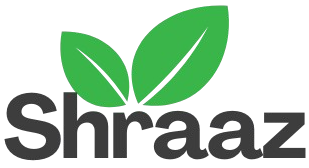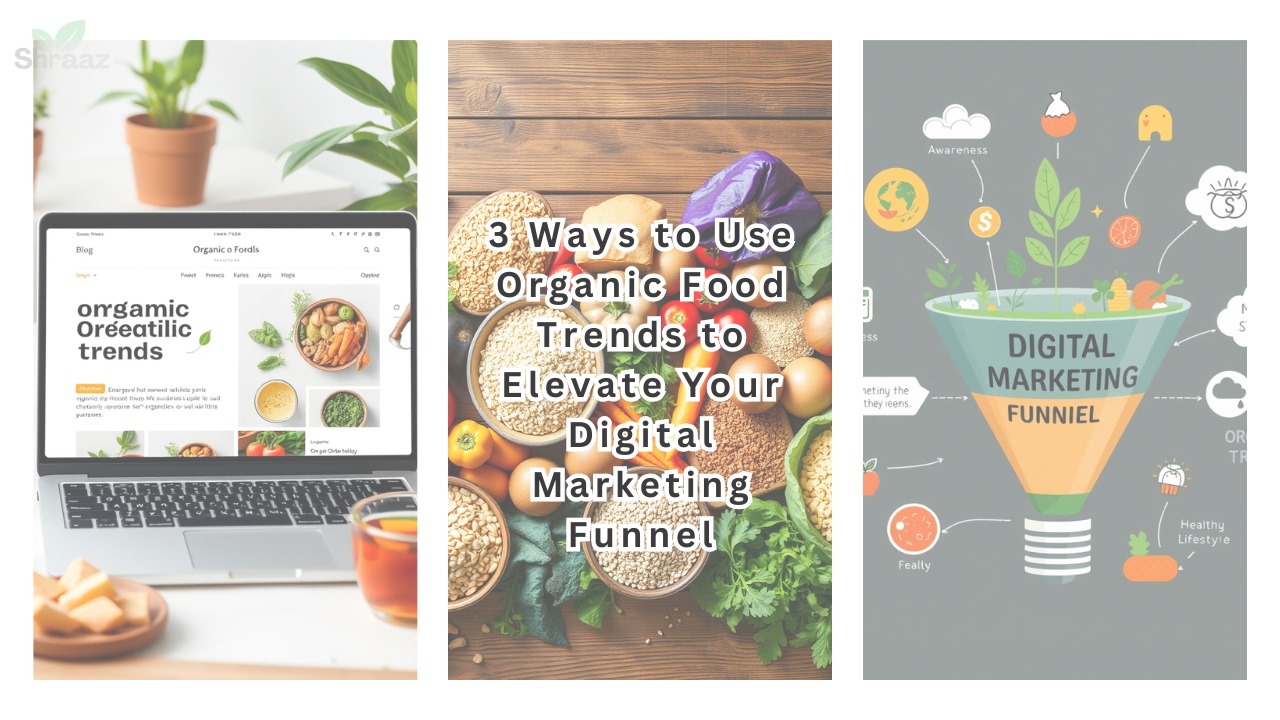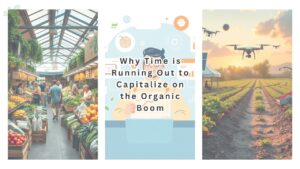Introduction
The organic food market is experiencing unprecedented growth, with consumers increasingly prioritizing health, sustainability, and authenticity. This trend offers immense opportunities for businesses to revamp their digital marketing funnels and align with consumer demands. By leveraging organic food trends, brands can attract and retain customers, driving long-term growth and loyalty.
In this article, we’ll explore three actionable strategies to incorporate organic food trends into your digital marketing funnel. From creating high-value content to targeting wellness-focused audiences, this guide provides insights and tools to maximize impact and stay ahead in the competitive digital landscape.
Overview of the Organic Food Market and Digital Marketing Synergy
The organic food market has grown exponentially in recent years, driven by shifting consumer priorities toward health and sustainability. According to Statista, the global organic food market was valued at approximately $220 billion in 2023, with a projected growth rate of 10% annually. This surge reflects not only increased awareness but also a demand for transparency and environmental responsibility.
Why Organic Food Trends Align with Digital Marketing:
- Consumer Behavior Insights: Organic food buyers are often tech-savvy and research-oriented, providing a fertile ground for digital engagement.
- Storytelling Opportunities: The journey of organic products—from farm to table—offers compelling narratives that can enhance brand storytelling.
- Trust and Transparency: Digital platforms allow brands to showcase certifications, ethical sourcing, and eco-friendly practices, fostering trust among consumers.
Organic Food Market Insights:
| Metric | Details |
| Market Value (2023) | $220 billion |
| Growth Rate | 10% annually |
| Top Consumer Preference | Health and sustainability |
| Key Demographics | Millennials and Gen Z, primarily urban dwellers |
By integrating these trends into digital strategies, businesses can effectively tap into a growing market while meeting consumer expectations for authenticity and value.
Strategy 1: Create High-Value Content for Lead Generation
Content marketing is a cornerstone of any successful digital marketing funnel. In the context of organic food trends, it becomes an even more potent tool to educate, engage, and convert potential customers.
Types of High-Value Content:
- Educational Blog Posts: Write articles on topics like the health benefits of organic foods, recipes, or sustainable farming practices.
- Interactive Content: Use quizzes or calculators to engage users (e.g., “How Organic Are Your Eating Habits?”).
- Video Content: Showcase behind-the-scenes farm tours, interviews with organic farmers, or cooking tutorials using organic ingredients.
- Infographics: Visualize key stats, such as the environmental impact of organic farming compared to conventional methods.
Content Optimization Tips:
- SEO Keywords: Include phrases like “organic food benefits,” “sustainable eating,” and “best organic brands.”
- Call-to-Actions (CTAs): Encourage readers to download a free eBook, subscribe to a newsletter, or sign up for a discount.
- Consistency: Regularly update content to keep it relevant and maintain audience interest.
Example: Effective Blog Content Structure
| Section | Details |
| Introduction | Brief overview of the topic (e.g., health benefits). |
| Data-Driven Insights | Include statistics and studies to build credibility. |
| Practical Tips | Share actionable advice (e.g., organic meal prep). |
| Call-to-Action (CTA) | Invite readers to explore more resources or products. |
By consistently delivering high-value content, businesses can position themselves as industry leaders while nurturing leads through the awareness stage of the marketing funnel.
Strategy 2: Use Organic-Themed Visuals and Messaging
Visual content and messaging play a critical role in shaping perceptions and building trust, especially in the organic food market. Consumers are drawn to authenticity, and your visuals and branding must reflect this ethos.
Organic-Themed Visuals:
- Nature-Inspired Imagery: Use high-resolution images of lush fields, fresh produce, and natural landscapes to evoke feelings of health and purity.
- Behind-the-Scenes Photos: Showcase the production process, from farming to packaging, to highlight transparency.
- Eco-Friendly Aesthetics: Incorporate design elements like earthy tones, minimalist typography, and eco-friendly packaging visuals.
Examples of Organic Messaging:
- Taglines: “From Farm to Fork, Naturally,” “Sustainability Starts Here.”
- Emotional Appeals: Highlight health benefits for families, environmental contributions, or ethical sourcing.
Impact of Visuals on Marketing Funnel:
| Funnel Stage | Visual Content |
| Awareness | Social media graphics showcasing organic benefits. |
| Consideration | Videos explaining product certifications. |
| Conversion | Testimonials with relatable visuals (e.g., families enjoying meals). |
By aligning visuals and messaging with organic food trends, businesses can strengthen their brand identity and encourage trust and loyalty.
Strategy 3: Target Wellness-Focused Audiences with Tailored Campaigns
A significant portion of organic food consumers are wellness-focused individuals who prioritize health, fitness, and sustainability. Crafting campaigns specifically for this audience can yield higher engagement and conversions.
Audience Insights:
- Demographics: Millennials and Gen Z are the primary buyers, with a focus on urban populations.
- Interests: Yoga, fitness, veganism, sustainability, and holistic living.
- Platforms: Instagram, Pinterest, and YouTube are popular for health and wellness content.
Tailored Campaign Strategies:
- Social Media Ads: Create ads featuring organic recipes, fitness influencers using your products, or sustainability tips.
- Partnerships: Collaborate with wellness influencers or eco-friendly brands for cross-promotional opportunities.
- Email Campaigns: Share exclusive offers, organic meal plans, or tips for sustainable living.
Example: Wellness-Focused Ad Copy
- Headline: “Fuel Your Body, Sustain the Planet – Try Our Organic Superfoods!”
- Visuals: A fitness enthusiast preparing a smoothie with organic ingredients.
- CTA: “Shop Now and Embrace Healthier Choices.”
By targeting wellness-focused audiences, businesses can tap into a motivated consumer base that values quality and sustainability, driving higher ROI on marketing efforts.
Integration Across the Digital Marketing Funnel
A successful digital marketing strategy doesn’t just implement isolated tactics; it integrates them across the funnel stages—awareness, consideration, and conversion. Leveraging organic food trends, businesses can create a cohesive journey that nurtures leads and maximizes conversions.
Awareness Stage: Building Initial Interest
- Content Marketing: Publish SEO-optimized blogs about organic food benefits and trends to attract traffic.
- Social Media Campaigns: Use nature-inspired visuals and engaging captions to highlight your brand’s commitment to health and sustainability.
- Video Ads: Create short, captivating videos featuring organic recipes or your product’s farm-to-table journey.
Example Funnel Activity:
A blog post titled “Top 10 Health Benefits of Going Organic” paired with a social media post linking to the blog and encouraging shares.
Consideration Stage: Educating and Nurturing Leads
- Email Campaigns: Send targeted emails with valuable resources, such as meal plans using your products or sustainability tips. Use personalization to appeal to specific audience segments.
- Webinars and Live Sessions: Host discussions with organic food experts or chefs to educate your audience while showcasing your brand.
- Case Studies: Share real-life examples of how your product improves health or supports the environment.
Example Funnel Activity:
A lead signs up for your free eBook, “Easy Organic Meals for Busy Families,” and receives follow-up emails showcasing your products in related recipes.
Conversion Stage: Encouraging Action
- Landing Pages: Design conversion-optimized pages with compelling CTAs, trust signals (e.g., organic certifications), and time-sensitive offers.
- Influencer Partnerships: Use influencers to promote discount codes or bundles exclusively for their followers.
- Retargeting Ads: Serve personalized ads to users who visited your website but didn’t convert, highlighting benefits they showed interest in.
Example Funnel Activity:
Retarget users who viewed your organic product page with ads like “Limited Offer: 20% Off All Organic Superfoods Today!”
Challenges and Solutions
While the organic food market is ripe with opportunity, businesses must navigate certain challenges to fully capitalize on it.
Common Challenges:
- High Competition: The rapid growth of the organic market means many brands are vying for consumer attention.
- Trust Issues: Consumers often question the authenticity of organic claims.
- Cost Concerns: Organic products are perceived as expensive, potentially alienating price-sensitive customers.
Solutions:
- Differentiate Your Brand: Focus on unique selling points, such as exclusive certifications, farm partnerships, or innovative product offerings.
- Build Trust with Transparency: Use storytelling to highlight your product’s journey, supported by certifications and customer reviews.
- Offer Value-Based Pricing: Introduce smaller, affordable packages or subscription plans to make organic products more accessible.
Example Approach:
A dedicated “Our Story” page on your website, shows your commitment to sustainability through videos and farmer testimonials.
Actionable Checklist for Marketers
To implement these strategies effectively, follow this actionable checklist:
| Step | Task |
| Research and Planning | Analyze consumer preferences and competitors. |
| Content Creation | Develop blogs, videos, and infographics aligned with organic trends. |
| Social Media Strategy | Design campaigns featuring visuals and messaging inspired by nature. |
| Email Marketing | Build segmented lists and send tailored content to nurture leads. |
| Ad Campaigns | Run targeted ads on platforms frequented by health-conscious audiences. |
| Website Optimization | Update landing pages with trust signals and clear CTAs. |
| Track Performance | Use analytics tools to monitor campaign results and refine strategies. |
Conclusion: The Future is Organic
Integrating organic food trends into your digital marketing funnel not only enhances your brand’s relevance but also drives sustainable growth. By creating high-value content, leveraging organic-themed visuals, and targeting wellness-focused audiences, businesses can forge deeper connections with consumers and stand out in a competitive market.
The organic boom is not just a trend—it’s a movement. The sooner you align your digital marketing strategies with this shift, the better positioned you’ll be to thrive in an evolving industry.




